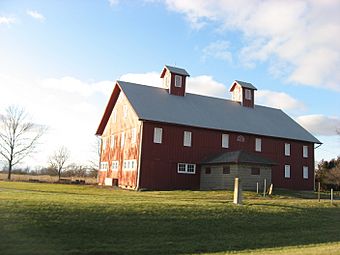Overmyer–Waggoner–Roush Farm facts for kids
Quick facts for kids |
|
|
Overmyer–Waggoner–Roush Farm
|
|

One of the barns at the farm
|
|
| Location | 654 S. Main St., Lindsey, Ohio |
|---|---|
| Area | 187 acres (76 ha) |
| Built | 1862 |
| Architect | Phillip C. Overmeyer |
| Architectural style | Greek Revival, Gothic Revival |
| NRHP reference No. | 83002055 |
| Added to NRHP | September 8, 1983 |
The Overmyer–Waggoner–Roush Farm, also called "Creek Bend Farm," is a special old farm. It's located near Lindsey in Ohio, USA. Most of its buildings were built in the mid-1800s. Today, this historic farm has become a park for everyone to enjoy. It's also recognized as an important historic site.
Contents
The Farm's Early History
The Overmyer Family Arrives
The Overmyer family came from Germany and settled in Pennsylvania in 1751. Phillip A. Overmyer, born in 1823, moved to Sandusky County, Ohio when he was ten. In 1848, he married Margaret Waggoner, who had also moved to the area.
Building the Farmstead
Phillip Overmyer was a farmer, but he also ran a sawmill and made wagons. In 1862, the Overmyers built their main farmhouse. It was made of brick and designed in the popular Greek Revival style. They also built barns and other buildings. Seven of these historic buildings are still standing today. Some even show parts of the Gothic Revival style.
New Owners: The Roush Family
By the early 1900s, the Roush family took over the farm. They owned and worked the land for more than a hundred years. The Roushes saw farming change from using animals to modern machines like tractors. Robert Roush, who passed away in 1999, was the last family member to run the farm. He cared a lot about nature. He tried new ideas like planting a tree farm and plowing his fields in circles. This helped protect the soil.
From Farm to Park
A New Purpose for the Farm
In 2004, Robert Roush's wife, Frances, gave the farm to Sandusky County. Her gift turned the farm into a county park. She also donated family journals and money to fix up two old barns. Local leaders were very happy about this. They saw the farm as a great place for nature and learning.
Why the Tree Farm Was Special
One of the most interesting parts was the tree farm Robert Roush had started. At that time, many Ohio farmers cut down trees to clear land. But Robert saw the value in keeping and planting trees. This made his farm unique. The farm was already famous before it became a park. It was added to the National Register of Historic Places in 1983. It was recognized for its important local history and its special buildings. Historians saw it as one of the best-preserved German family farms from the 1800s.
Plans for the Park
After getting the farm, the Sandusky County Park District made plans. They wanted to build a visitor center and turn some farmland along Muddy Creek into a wetland. They also planned to restore the old barns. The park district also started a program to show how farming changed over time. A local history group began farming parts of the land using old equipment from the early 1900s. They used modern machines on other parts. This helps visitors see how technology improved farming.
Visiting the Park Today
Today, the park covers 310 acres (130 ha). The Park District is working to make it look like a farm from the 1930s to the 1950s. You can't go inside the old buildings yet, but you can hike on marked trails. The park offers other fun activities too. These include skiing, geocaching, watching nature, and even metal detecting.
Protecting the Trees
In 2007, the Park District had to remove thirty-one ash trees. These trees were expected to be destroyed by the Emerald ash borer, a tiny insect. This insect had already harmed many other ash trees in northwestern Ohio. The wood from the removed trees was then used to replace flooring in one of the barns.



